3rd January 2019. Etihad Stadium. Manchester, England. Title rivals Manchester City and Liverpool clash. A win for Liverpool sees them increase their advantage at the top of the table to 10 points. A Manchester City win and the lead would be down to just four points. Manchester City would go on to win the match 2-1 and ultimately go on win the title that season by one point, whilst Liverpool would go on to win the UEFA Champions League. Fast forward 18 months and Liverpool travel to Manchester as Premier League Champions. The Reds having already sealed their 19th league title with a record seven games left to play. This match, although irrelevant in terms of deciding who would become champions, presented an opportunity for both teams to make a statement of intent.
To lay down a marker for next season. This match was dubbed by many pundits as ‘the first match of 2020/21’. A chance for Liverpool to stamp their authority over the second-best team in the league, to show the world exactly why they were 23 points clear at the top of the table. For Pep Guardiola’s Man City, it represented a chance to show Liverpool that they were not a spent force and to win the mental battle in advance of next season. Fireworks could be heard outside the Etihad on Thursday evening – presumably in support of the newly crowned Champions of England. Yet the only fireworks on the pitch were all in favour of Man City. The ‘Citizens’ were respectful and welcomed the Champions to the pitch with a guard of honour. Once the match started, City were rabid and driven. Determined to prove a point following their loss to Chelsea last week.
In this tactical analysis, we will delve into the tactics of the match and provide an analysis of how Guardiola was able to out-smart Liverpool’s Jürgen Klopp and ran away deserved 4-0 winners.
Lineups
There were no surprises with Liverpool’s team selection. Klopp opting to field without a doubt his preferred starting 11. Alisson Becker lined up with the usual back four of Trent Alexander-Arnold, Joe Gomez, Virgil Van Dijk, and Andrew Robertson. Fabinho was deployed in the defensive-midfielder role, or number six. Georginio Wijnaldum lined up alongside captain Jordan Henderson, and the usual front three of Mohamed Salah, Sadio Mané and Roberto Firmino completed Liverpool’s customary 4-3-3.
Man City did spring a surprise though. Guardiola has long been an advocate of a 4-3-3 and has had limited success versus Klopp and Liverpool when using it. The change to 4-2-3-1 and the deployment of Kevin De Bruyne in the number 10 was a masterstroke by the Spaniard. A back four of Kyle Walker, Eric García, Aymeric Laporte and Benjamin Mendy sat in front of Ederson in the City goal. A midfield double pivot of Rodri and İlkay Gündoğan supplied De Bruyne, Phil Foden, Raheem Sterling, and striker Gabriel Jesus, completing the City 4-2-3-1 – A formation that City have had success with against Liverpool in the past.
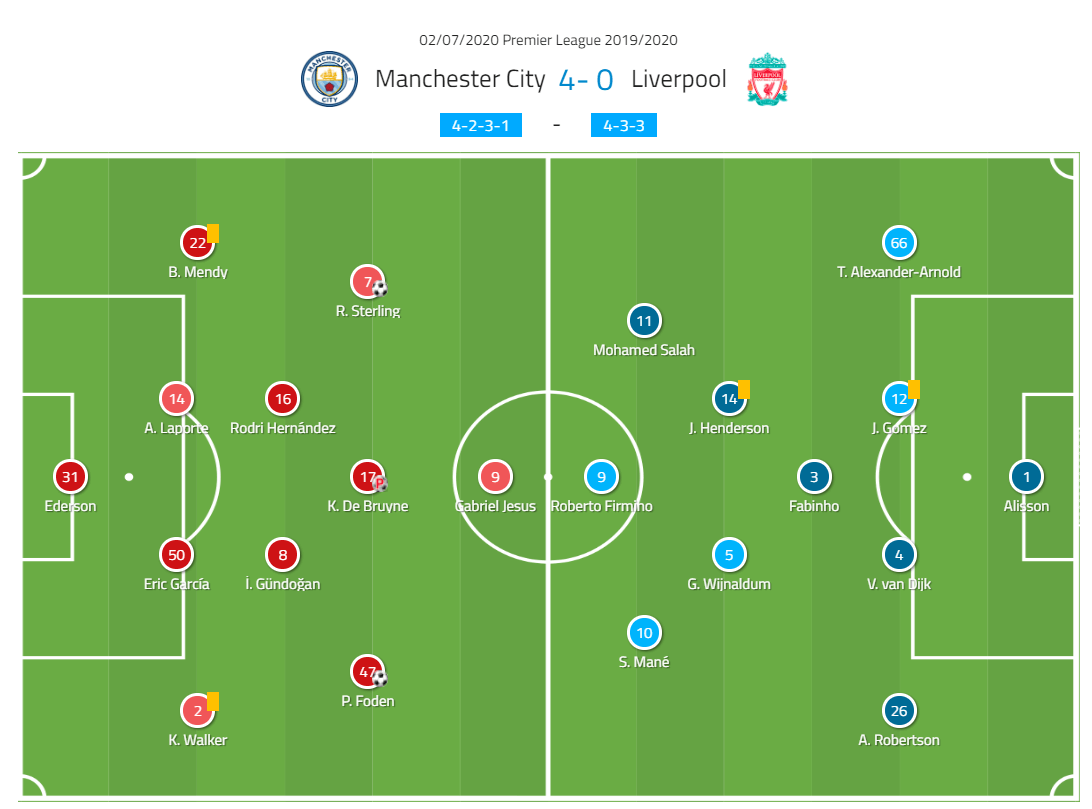
Liverpool started brighter but failed to capitalise.
The Reds flew out of the gate and had some early success creating chances with long balls over the top of the City defence. Most typically from Van Dijk or Alexander-Arnold looking to pick out out-in runs from Salah or Mané. If we look at the example below, we can see Van Dijk look to clip a ball in behind for Salah to run onto.
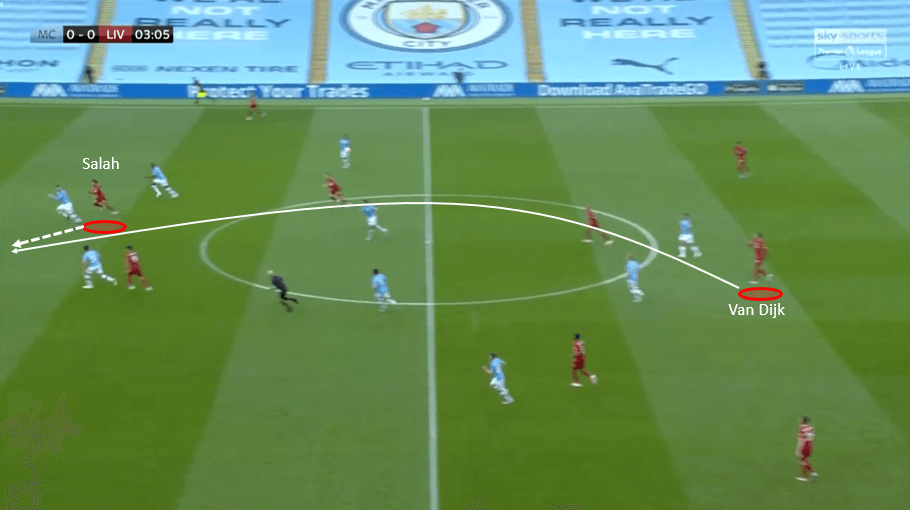
Liverpool had success with this tactic on several occasions in the first 15 minutes. Below, we see another example – this time the pass coming from Henderson in the typical right-back position.
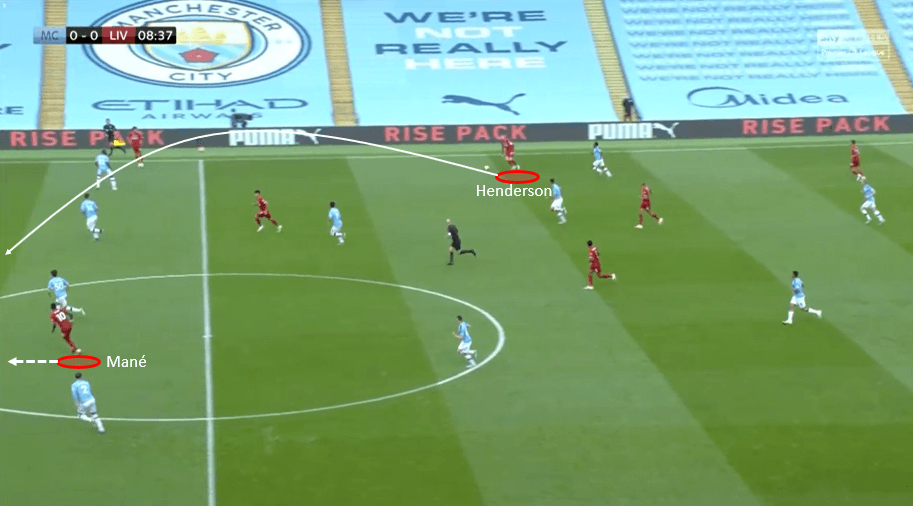
Whilst playing long to release the speedy front three did create some half chances for Liverpool, they were not able to capitalise with Salah hitting the post in the 19th minute being the closest Liverpool came to a goal. For the first 20 minutes, Liverpool had limited City to <0.01 xG and had created 0.72 xG themselves. If Liverpool had scored during the first 20 minutes, we could have witnessed an entirely different match.
Liverpool were causing City problems. City were holding a high line and the pace of Mané and Salah in behind was giving them constant headaches. Guardiola needed to change something before Liverpool scored. This leads us onto the next section of this analysis.
Not having possession was more beneficial
With both teams being brilliant in transition, having possession of the ball was more dangerous than you would expect. In the first 15 minutes, City had around 61% possession and this suited Liverpool being able to press and create chances in transition. As the first-half wore on, City relinquished possession at various points and at times allowed Liverpool to have up to 57% of the ball. This was a big turning point in the match as it allowed City to have their turn at hurting Liverpool in transition.
City were incredibly direct and would often look to attack at the heart of Liverpool’s defence. On many occasions, City would look to invite Liverpool on, before winning the ball back and releasing one of Jesus, De Bruyne, Sterling or Foden in behind. With these four all linking up to cause problems for the Liverpool defence. Liverpool should have read the warnings after Jesus was narrowly ruled off-side in the 18th minute when ‘1 vs 1’ with Alisson. Gündoğan received the ball from Ederson, split Liverpool’s midfield finding De Bruyne in between the lines, who in turn split Liverpool’s back four for Jesus to run onto. From goalkeeper to the shot in 10 seconds – albeit off-side, but Liverpool should have heeded the warning.
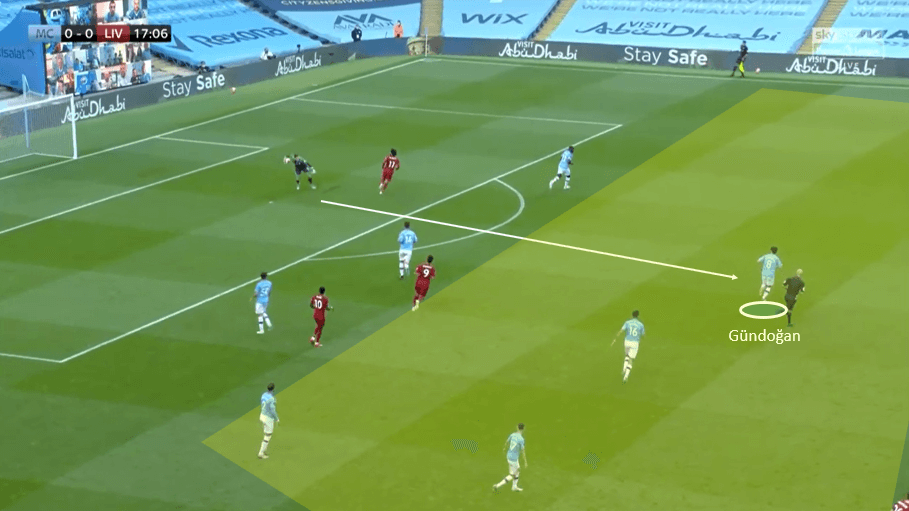
Ederson bypasses Liverpool’s front three, with Gündoğan receiving in plenty of space between the lines. Below we can see De Bruyne receiving in acres of space, once again in between the lines.
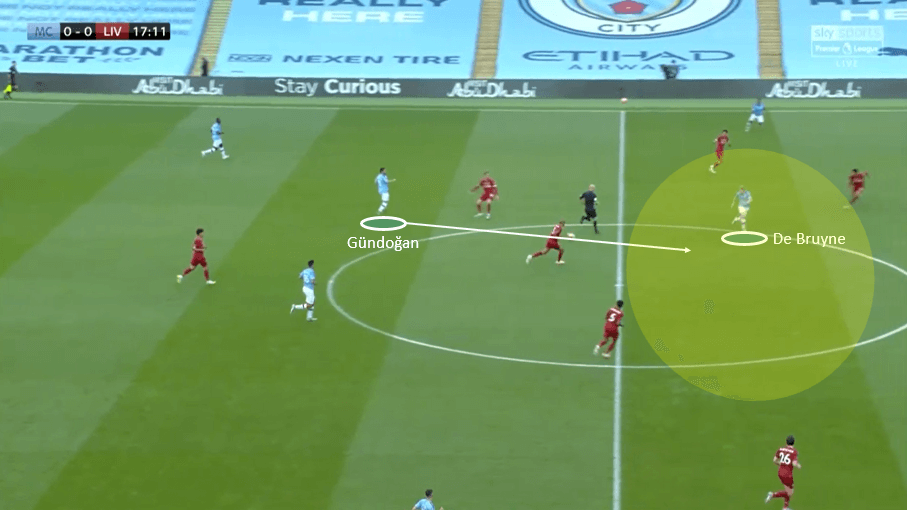
It may be coincidental that the period when City scored three of their four goals also happened to be in periods when they had less possession.
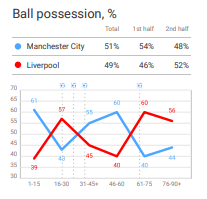
The double-pivot beat Liverpool’s press
Liverpool are renown for their counter-pressing or ‘gegenpressing’. City have encountered problems when playing out against the all-action front six (forwards and midfielders). This has often been the case when City have matched Liverpool’s 4-3-3 with a 4-3-3 of their own. We can see an illustration of this below.
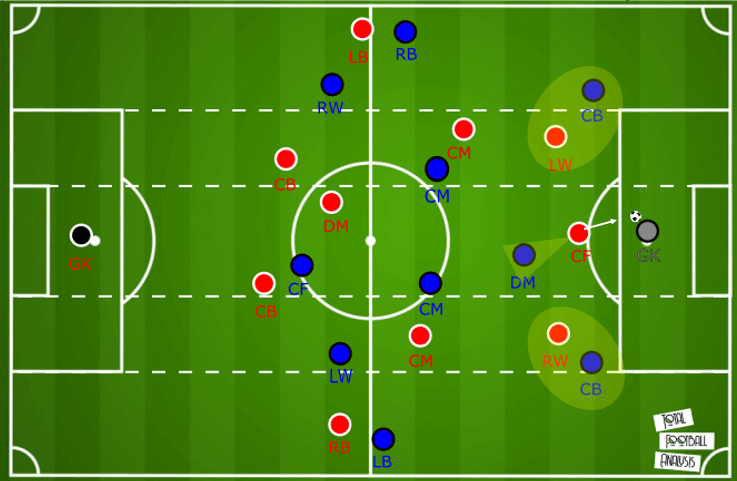
As we can see above, If City were to play a 4-3-3, pushing their full-backs up in the process. It allows Liverpool to go ‘3 vs 4’ versus City’s centre-backs, number six, and goalkeeper. Firmino (CF) is able to press the goalkeeper and cast a pressing shadow over the DM. Whilst Mané and Salah (LW and RW) are able to man-mark the two centre-backs and Liverpool’s centre-midfielders mark their opposite numbers – forcing City into playing long term thus creating an aerial duel or a loose ball duel, which Liverpool would prefer than allowing City to play out from the back.
However, with City opting for a 4-2-3-1 and therefore a double-pivot. It negates Liverpool’s front three press as they were able to bypass the press.
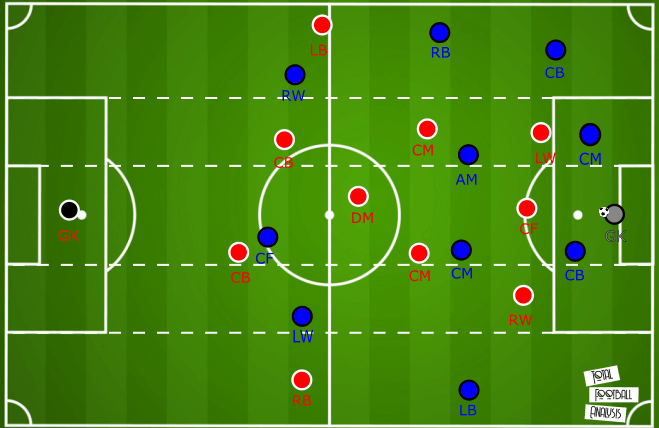
As we can see, the presence of a midfield two for City gives them an ‘8 vs 6’ overload when playing out from the back and gives City keeper Ederson several passing options, enabling them to play through the lines. De Bruyne (AM) drops in to allow a central midfielder to drop deeper to assist in playing out from the back. This causes Liverpool problems as Firmino (CF) is unable to block both passing lanes into the midfield. Liverpool’s full-backs are pinned back by the presence of City’s wingers and Liverpool’s midfield three could all push-up, but this leaves them exposed to quick counters by City. This is exactly what happened in the match and it left Liverpool soft and fragile in the middle of the park. An example is shown below.
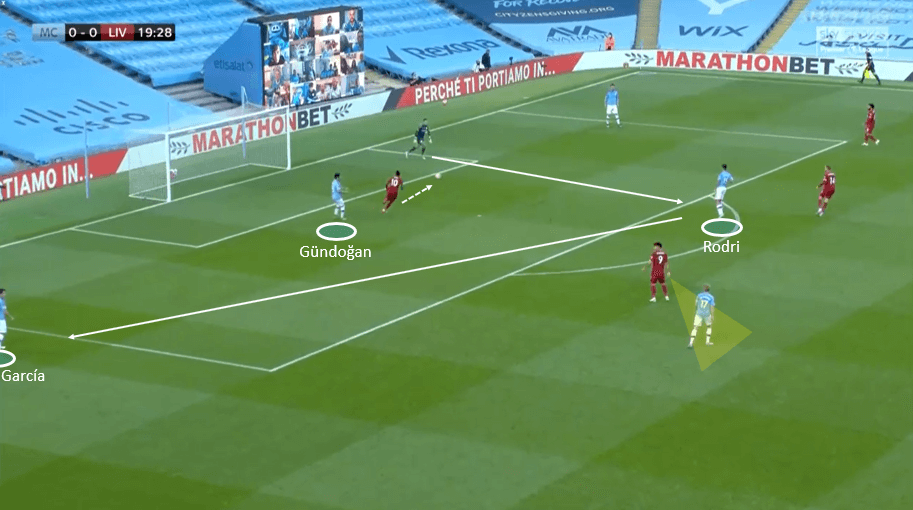
As mentioned above, the presence of Gündoğan in the deeper position allows García to get as wide as you would usually find a right-back. Mané presses in vain as City are able to bounce a pass off Rodri and out-wide to García – who is free to advance with the ball into space before progressing the ball into the next phase of play.
The Kevin De Bruyne show
The Belgian is widely regarded as one of the best players of his generation and is, without a doubt, one of – if not the most – creative player in the Premier League. De Bruyne had a significant impact on the match with somewhat of a free role. He lined up as an attacking midfielder, yet on occasion would pop up as a holding midfielder, the left-wing and even as a second striker. De Bruyne ran the show and was deserved man of the match. De Bruyne was responsible for six deep completions, four key passes and four shot assists, as well as taking four shots of his own. We can see all of City’s key passes in the image below.
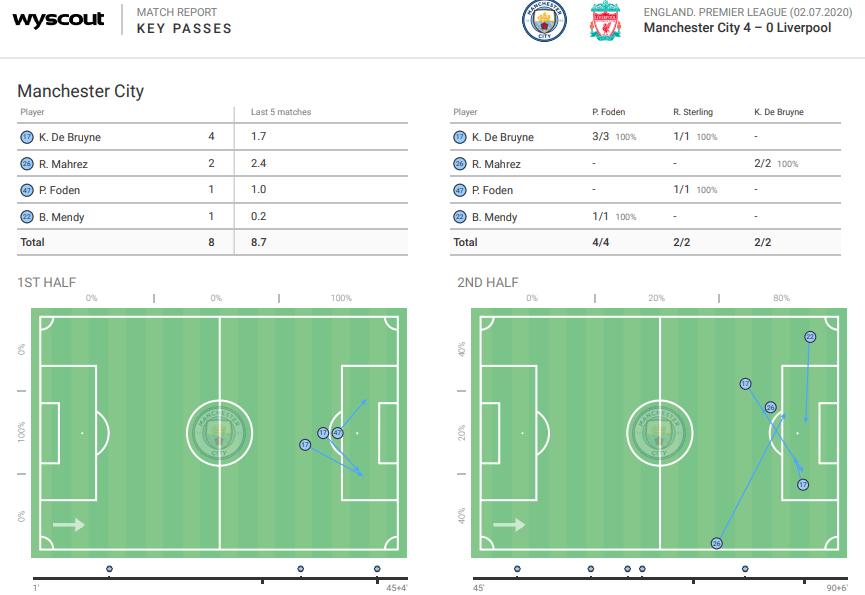
Let us look at how De Bruyne was able to have such an influence on the match. In the below example, we see De Bruyne recognises that Robertson is out of position and plays an inch perfect pass to Jesus that cuts out four Liverpool players.
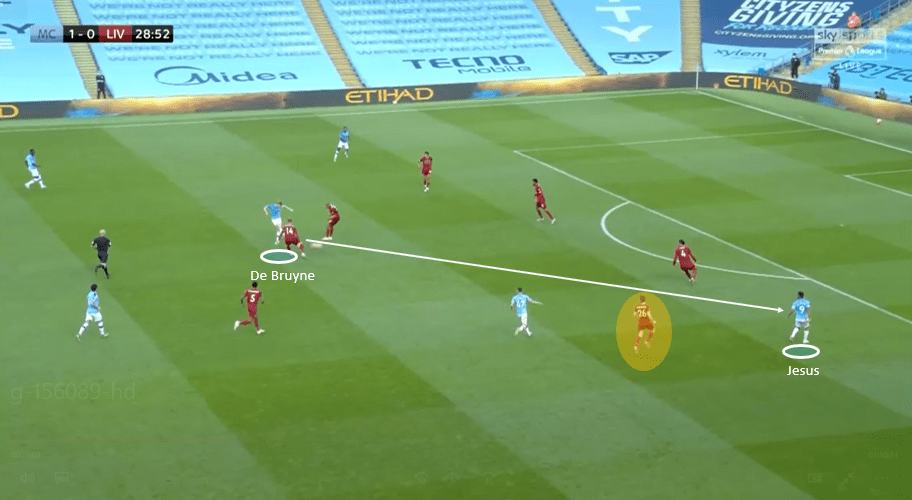
De Bruyne was a constant problem for Liverpool. He was pulling the strings for City, dictating play, and creating chances. His ability to recognise space and continuously position himself in dangerous areas was impressive and Liverpool struggled to pick him up. In the below example, we see De Bruyne drift into ample space just inside Liverpool’s area.
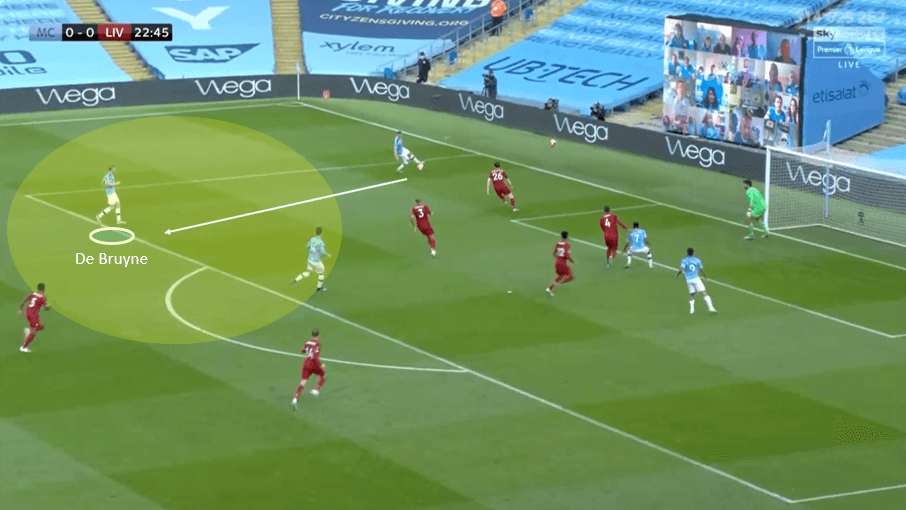
Whether it was down to Liverpool being lethargic and ’on the beach’ as the saying goes, or De Bruyne’s clever movement off the ball, the Belgian was able to pick up pockets of space in between the lines of Liverpool’s defence and midfield and hurt Liverpool with his passing ability.
In the image below, we see De Bruyne, again, find himself in space and he is able to get in behind Liverpool’s back line, and cuts a pass back for Foden to fire a shot on goal, with only a goal-line clearance by Van Dijk preventing another assist for the Belgian.
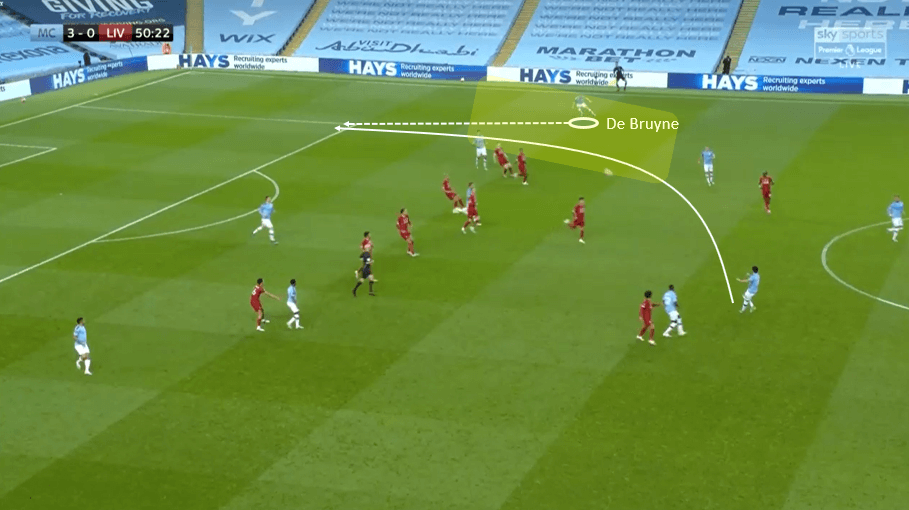
City’s direct approach
Going into half-time with a 3-0 lead, City were in the fortunate position of sitting back and inviting Liverpool onto them and hitting them with counters that were deadly, direct, and dangerous.
If we look at the focus of attacks for both teams, we can see that City focused heavily on creating chances on their left-hand side but by far City’s most threatening attacks came through the middle, with 81% of City’s xG coming from attacks that were central.
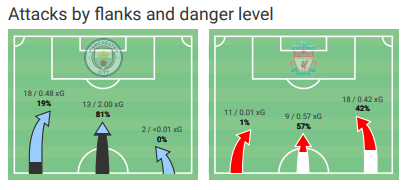
In the second half, in particular, City were able to rely on their counter-attacking abilities to counteract Liverpool’s high line. City would regain possession and then look to capitalise in transition as Liverpool quickly scampered to get into a defensive shape. In the example below, we see City win the ball in the yellow area and as soon as possible, City look to break on Liverpool with a chipped pass to De Bruyne who is in acres of space – once again.
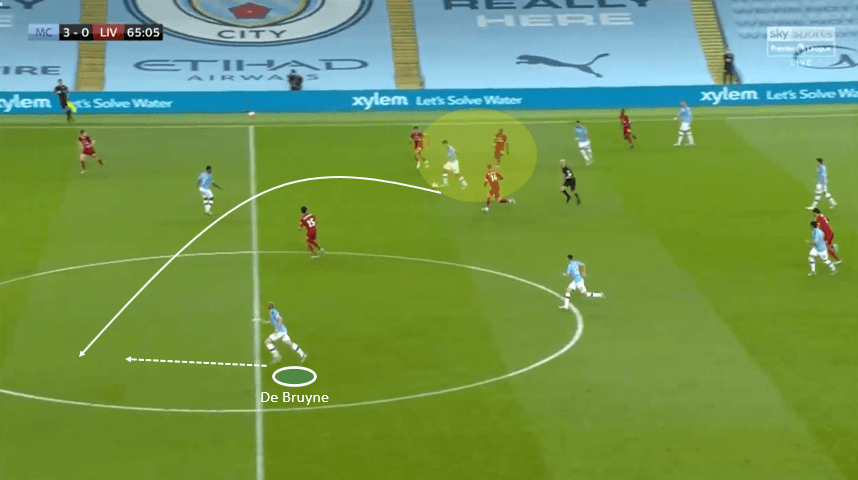
De Bruyne profits from a Robertson mistake as the Scot tracks Foden’s run – which is already being tracked by Alex Oxlade-Chamberlain, leaving Sterling free at the back post, who goes on to fire a shot away that is turned in by Oxlade-Chamberlain.
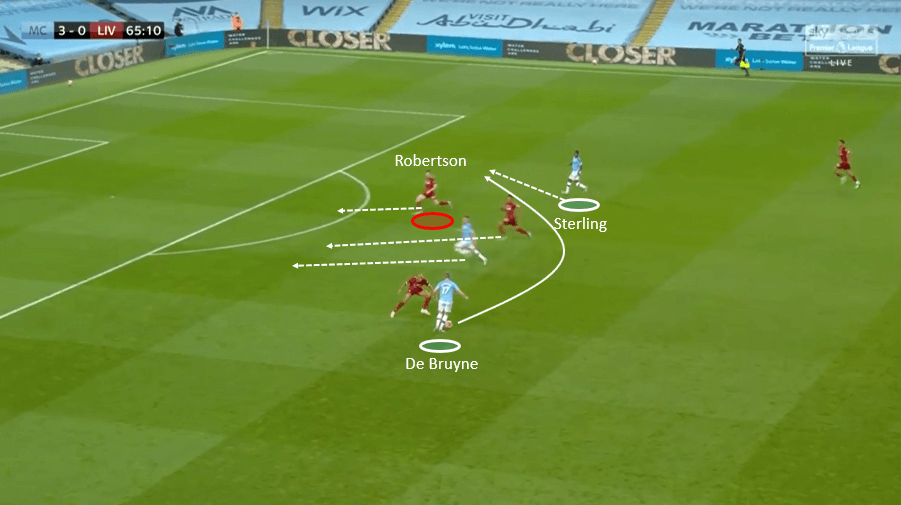
Liverpool’s crossing game was ineffective
With your team’s greatest creative influences being the full-backs, it would be safe to assume that your team will deliver a fair number of crosses and Liverpool do exactly that. Alexander-Arnold delivers a fantastic cross and is a constant threat to defences, along with Robertson on the opposite flank, they are Liverpool’s primary creative outlets. City managed to negate their creative influence. The image below details all 19 of Liverpool’s crosses in the match – for reference City made a mere eight crosses.
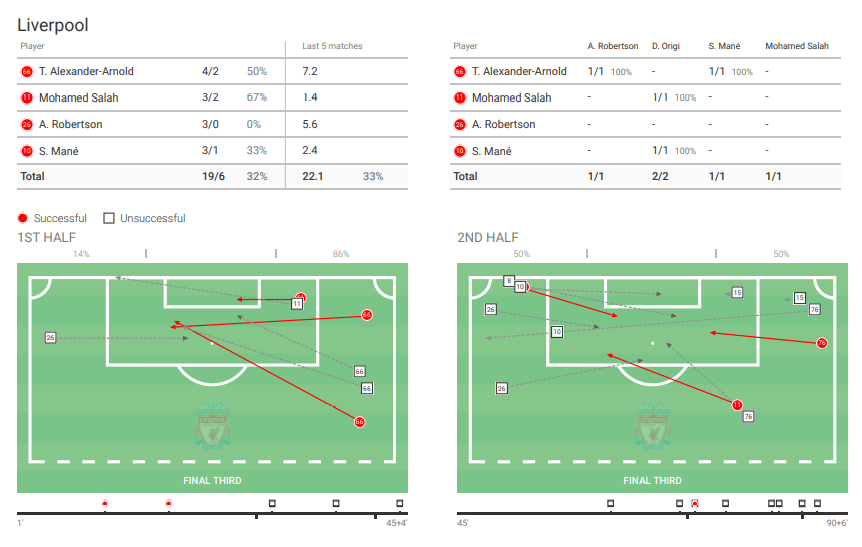
As we can see Alexander-Arnold attempted four crosses, with only two being successfully completed, with an average of 7.2 over the last five matches. The story for Robertson is even more impressive for City, with none of Robertson’s three attempted crosses being completed. If we take a look at how City prevented Liverpool’s full-backs having their usual influence, it becomes clear that City looked to overload the penalty area and within the width of the six-yard box in particular, with six players initially in the yellow lines that extend the six-yard box. Enabling them to win the duel and clear the ball.
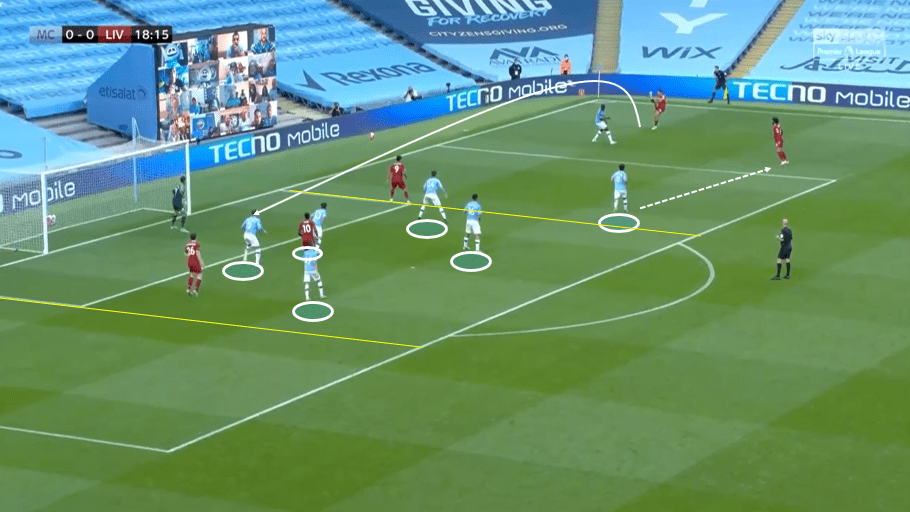
Below we see another example of City dealing with crosses. Once again, we can see that City have that central overload with five players to Liverpool’s two. This was a key tactical implementation by Guardiola that prevented Liverpool’s full-backs from having the creative influence that they usually have.
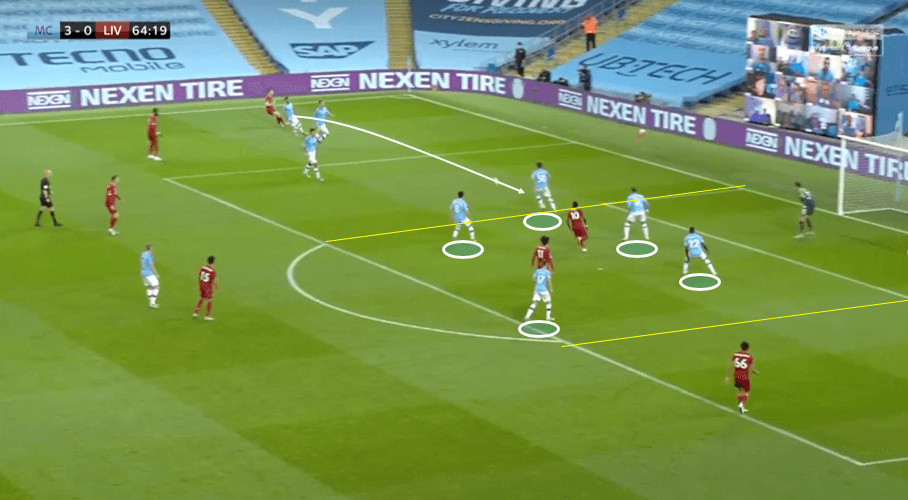
Conclusion
An interesting game where City ran riot from the 15th minute until half-time. At 3-0, the second half was quite a procession. City continued to punish Liverpool on the counter and dealt with Liverpool’s crosses in an efficient manner. Whilst it could be said that Liverpool were sloppy and could probably be excused for only their third league loss in two seasons. Klopp surely would not have been happy with his team’s performance. City were ruthless, relentless, and clinical and full deserved their victory.





Comments